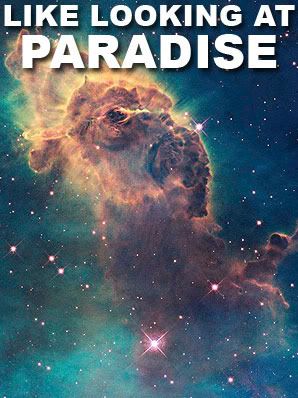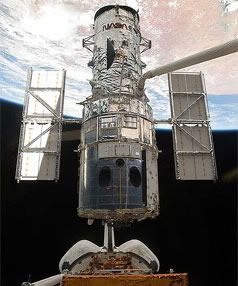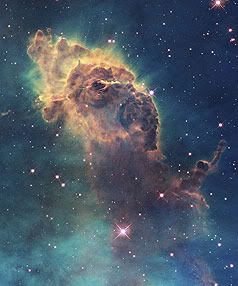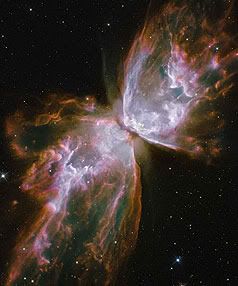Kiwithrottlejockey
Admin Staff
XNC2 GOD

Posts: 32251
Having fun in the hills!
|
 |
« on: July 01, 2010, 08:46:19 pm » |
|
‘It's like looking at paradise’By GLENDA KWEK - Sydney Morning Herald | 5:16PM - Thursday, 01 July 2010 They spent eight months learning how to use the camera, just so they could shoot eight minutes of 3D footage. They spent eight months learning how to use the camera, just so they could shoot eight minutes of 3D footage.
But this was no ordinary film.
The camera operators were astronauts, highly trained specialists and ex-military veterans.
They had travelled up into space on the space shuttle Atlantis last year, carrying with them a 3D camera.
Their mission: to dock with the Hubble telescope — a bus-sized spacecraft orbiting Earth — and perform repairs on it, while also capturing 3D video of the Hubble and our planet. TO BOLDLY FILM: The Hubble space telescope, TO BOLDLY FILM: The Hubble space telescope,
as seen from the space shuttle Atlantis.
— Photo: NASA.The result was Hubble 3D, a breathtaking collection of images about the history of the telescope and of our known universe.
The limited amount of 3D footage that could be shot in space was a result of physical constraints.
The film roll on board the Atlantis was the largest in the world, with the film strip 1.52-kilometres long and weighing 24.5 kilograms.
The 317-kilogram camera had to be packed into the space shuttle's cargo bay using a crane, and became part of the craft's ballast.
The result was only eight minutes of actual 3D imagery in space, mostly featuring the astronauts as they struggled to fix the telescope while they were in a constant state of free fall.
Beyond them, the luminous blue and white colours of the Earth's surface provide a unique backdrop.
The other 35 minutes gave scientists and film-makers the opportunity to use computer simulation to bring to life the images and data Hubble has been sharing with us over the past two decades.
Hubble — sometimes called the "time machine" — has given us a glimpse of the world beyond us, sometimes going back as far as 13 billion years ago, long before the Earth even existed.
With the data it has sent back, scientists have been able to make some of our most significant discoveries.
Some memorable photos include the vast Carina Nebula, an interstellar cloud of dust and gas 6500 light years away, and the births and deaths of stars.  FAR, FAR AWAY (left): Gas pillars in the Eagle Nebula. | INFLIGHT MOVIE (right): A butterfly FAR, FAR AWAY (left): Gas pillars in the Eagle Nebula. | INFLIGHT MOVIE (right): A butterfly
emerges from as a star dies in Planetary Nebula NGC 6302. | — Both Photos: NASA.While the fantasy 3D world of Pandora in Avatar, with its sweeping landscapes, glowing fauna and mythical creatures wowed mainstream audiences last year, the creators of the 43-minute-long Hubble 3D hope to generate similar excitement using the vastness and other-worldly beauty of our real world.
"No one can describe the beauty of what you're seeing. If you were in heaven and could look down on our Earth, this is what the view would be," says Michael Massimino, one of the astronauts on board the Discovery spaceship mission to Hubble in 2009 when the 3D footage was shot.
"It's like looking at paradise. It's perfection."
The film is pitched at children and families, and occasionally suffers from a script that is too simple for today's sophisticated and well-read youth.
But it certainly succeeds in giving us the feeling that we are in space. As director Toni Myers says, it's "the next best thing to being there".
In Sydney, two projectionists race around a noisy and dark room before the Hubble 3D screening, feeding two huge and heavy roll of films, one for the left eye and the other for the right, onto a reel like boys working in a giant's workshop.
The costs are also staggering compared to normal cinema. Each 3D projector is worth about $1.6 million, as opposed to $120,000 for a 2D film projector.
Yet as the reel rolls and space flickers into life before your eyes, there is no doubting the thrill of flying through computer simulations extrapolated from Hubble's immerse collection of data and images.
Witnessing the birth of stars in Orion's Belt, one of our skyline's most recognisable constellations, is particularly awe-inspiring, and reminds us of our small place in this vast universe we call home.http://www.stuff.co.nz/entertainment/film/3875708/Its-like-looking-at-paradise
|
If you aren't living life on the edge, you're taking up too much space!   |
|
|
|


|
|
|
|